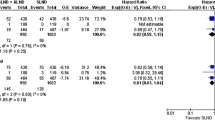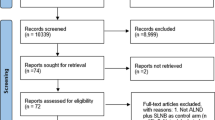Abstract
There are divergent opinions regarding the optimum surgical management of the axilla in patients with invasive breast cancer. Guidelines mandate axillary lymph node dissection (ALND) in the setting of positive sentinel lymph nodes. However, recent studies have questioned the true benefits of this procedure. Therefore, a meta-analysis of relevant randomized trials was performed in order to clarify the oncological benefit of axillary lymph node dissection. A comprehensive search of published randomized trials that compared patients with primary operable breast cancer with/without ALND was performed using MEDLINE, and available data were cross-referenced. Reviews of each study were conducted, and data were extracted. Primary outcomes were overall survival and recurrent axillary disease. A total of 7347 patients with operable primary breast cancer were identified from 8 randomised controlled trials comparing axillary recurrence in patients with or without ALND. Six of these trials provided data on overall survival on 6895 patients. Overall survival favours patients having ALND (OR = 1.22 (95 % CI 1.03–1.44, p = 0.02). Similarly, patients undergoing ALND had increased recurrence-free survival (OR = 2.25 (95 % CI 1.28–3.94, p = 0.0047). ALND appears to positively impact on overall and recurrence-free survival from breast cancer. These data highlight the enduring benefits of ALND in an era where adjuvant therapies are being promoted to manage regionally advanced/metastatic disease.



Similar content being viewed by others
References
Halsted WSI (1894) The results of operations for the cure of cancer of the breast performed at the Johns Hopkins hospital from June, 1889, to January, 1894. Ann Surg 20(5):497–555
Fisher B (1992) The evolution of paradigms for the management of breast cancer: a personal perspective. Cancer Res 52(9):2371–2383
Krag DN, Anderson SJ, Julian TB et al (2007) Technical outcomes of sentinel-lymph-node resection and conventional axillary-lymph-node dissection in patients with clinically node-negative breast cancer: results from the NSABP B-32 randomised phase III trial. Lancet Oncol 8:881–888
Veronesi U, Paganelli G, Viale G et al (2003) A randomized comparison of sentinel-node biopsy with routine axillary dissection in breast cancer. N Engl J Med 349:546–553
Cyr A, Gillanders WE, Aft RL et al (2010) Micrometastatic disease and isolated tumor cells as a predictor for additional breast cancer axillary metastatic burden. Ann Surg Oncol 17(Suppl. 3):S303–S311
Cox CE, Kiluk VJ, Riker AI et al (2008) Significance of sentinel lymph node micrometastases in human breast cancer. J Am Coll Surg 206:261–268
Reed J, Rosman M, Verbanac KM et al (2009) Prognostic implications of isolated tumor cells and micrometastases in sentinel nodes of patients with invasive breast cancer: 10-year analysis of patients enrolled in the prospective East Carolina University/Anne Arundel Medical Center sentinel node multicenter study. J Am Coll Surg 208:333–340
De Boer M, van Deurzen C, van Dijck J et al (2009) Micrometastases or isolated tumor cells and the outcome of breast cancer. N Engl J Med 361:653–663
Truong PT, Vinh-Hung V, Cserni G et al (2008) The number of positive nodes and the ratio of positive to excised nodes are significant predictors of survival in women with micrometastatic node-positive breast cancer. Eur J Cancer 44:1670–1677
Colleoni M, Rotmensz N, Peruzzotti G et al (2005) Size of breast cancer metastases in axillary lymph nodes: clinical relevance of minimal lymph node involvement. J Clin Oncol 23:1379–1389
Giuliano AE, McCall L, Beitsch P et al (2010) Locoregional recurrence after sentinel lymph node dissection with or without axillary dissection in patients with sentinel lymph node metastases: the American College of Surgeons Oncology Group Z0011 randomized trial. Ann Surg 252(3):426–432
Martelli G, Boracchi P, De Palo M, Pilotti S, Oriana S, Zucali R, Daidone MG, De Palo G (2005) A randomized trial comparing axillary dissection to no axillary dissection in older patients with T1N0 breast cancer: results after 5 years of follow-up. Ann Surg. 242(1):1–6 discussion 7–9
Giuliano AE, Hunt KK, Ballman KV, Beitsch PD, Whitworth PW, Blumencranz PW, Leitch AM, Saha S, McCall LM, Morrow M (2011) Axillary dissection vs no axillary dissection in women with invasive breast cancer and sentinel node metastasis: a randomized clinical trial. JAMA 305(6):569–575
Louis-Sylvestre C, Clough K, Asselain B, Vilcoq JR, Salmon RJ, Campana F, Fourquet A (2004) Axillary treatment in conservative management of operable breast cancer: dissection or radiotherapy? Results of a randomized study with 15 years of follow-up. J Clin Oncol 22(1):97–101
International Breast Cancer Study Group, Rudenstam CM, Zahrieh D, Forbes JF, Crivellari D, Holmberg SB, Rey P, Dent D, Campbell I, Bernhard J, Price KN, Castiglione-Gertsch M, Goldhirsch A, Gelber RD, Coates AS (2006) Randomized trial comparing axillary clearance versus no axillary clearance in older patientswith breast cancer: first results of International Breast Cancer Study Group Trial 10-93. J Clin Oncol 24(3):337–344
Canavese G, Catturich A, Vecchio C, Tomei D, Gipponi M, Villa G, Carli F, Bruzzi P, Dozin B (2009) Sentinel node biopsy compared with complete axillary dissection for staging early breast cancer with clinically negative lymph nodes: results of randomized trial. Ann Oncol 20(6):1001–1007
Zavagno G, De Salvo GL, Scalco G, Bozza F, Barutta L, Del Bianco P, Renier M, Racano C, Carraro P (2008) Nitti D; GIVOM Trialists. A Randomized clinical trial on sentinel lymph node biopsy versus axillary lymph node dissection in breast cancer: results of the Sentinella/GIVOM trial. Ann Surg 247(2):207–213
Martelli G, Boracchi P, Ardoino I, Lozza L, Bohm S, Vetrella G, Agresti R (2012) Axillary dissection versus no axillary dissection in older patients with T1N0 breast cancer: 15-year results of a randomized controlled trial. Ann Surg 256(6):920–924
Solá M, Alberro JA, Fraile M, Santesteban P, Ramos M, Fabregas R, Moral A, Ballester B, Vidal S (2013) Complete axillary lymph node dissection versus clinical follow-up in breast cancer patientswith sentinel node micrometastasis: final results from the multicenter clinical trial AATRM 048/13/2000. Ann Surg Oncol 20(1):120–127
Krag DN, Anderson SJ, Julian TB, Brown AM, Harlow SP, Costantino JP, Ashikaga T, Weaver DL, Mamounas EP, Jalovec LM, Frazier TG, Noyes RD, Robidoux A, Scarth HM, Wolmark N (2010) Sentinel-lymph-node resection compared with conventional axillary-lymph-node dissection inclinically node-negative patients with breast cancer: overall survival findings from the NSABP B-32 randomised phase 3 trial. Lancet Oncol 11(10):927–933
Joyce DP, Lowery AJ, McGrath-Soo LB, Downey E, Kelly L, O’Donoghue GT, Barry M, Hill AD (2015) Management of the axilla: has Z0011 had an impact? Ir J Med Sci
Giuliano AE, Morrow M, Duggal S et al (2012) Should ACOSOG Z0011 change practice with respect to axillary lymph node dissection for a positive sentinel lymph node biopsy in breast cancer? Clin Exp Metastasis 29(7):687–692
Sanghani M, Balk EM, Cady B (2009) Impact of axillary lymph node dissection on breast cancer outcome in clinically node negativepatients: a systematic review and meta-analysis. Cancer 115(8):1613–1620
Zhang PZ, Chong L, Zhao Y, Gu J, Tian JH, Yang KH (2013) Is axillary dissection necessary for breast cancer in old women? A meta-analysis ofrandomized clinical trials. Asian Pac J Cancer Prev 14(2):947–950
Wang Z, Wu LC, Chen JQ (2011) Sentinel lymph node biopsy compared with axillary lymph node dissection in early breast cancer: a meta-analysis. Breast Cancer Res Treat 129(3):675–689. doi:10.1007/s10549-011-1665-1
Morrow M, Harris JR, Schnitt SJ (2012) Surgical margins in lumpectomy for breast cancer–bigger is not better. N Engl J Med 367(79–82):11
Fisher B, Dignam J, Bryant J, DeCillis A, Wickerham DL, Wolmark N et al (1996) Five versus more than five years of tamoxifen therapy for breast cancer patients with negative lymph nodes and estrogen receptorpositive tumors. J Natl Cancer Inst 88:1529–1542
Fisher B, Dignam J, Mamounas EP, Costantino JP, Wickerham DL, Redmond C et al (1996) Sequential methotrexate and fluorouracil for the treatment of node-negative breast cancer patients with estrogen receptor-negative tumors: eight-year results from National Surgical Adjuvant Breast and Bowel Project (NSABP) B-13 and first report of findings from NSABP B-19 comparing methotrexate and fluorouracil with conventional cyclophosphamide, methotrexate, and fluorouracil. J Clin Oncol 14(1982–92):13
Romond EH, Perez EA, Bryant J, Suman VJ, Geyer CE Jr, Davidson NE et al (2005) Trastuzumab plus adjuvant chemotherapy for operable HER2-positive breast cancer. N Engl J Med 353:1673–1684
Author information
Authors and Affiliations
Corresponding author
Ethics declarations
Conflict of interest
The authors declare that they have no conflict of interest.
Rights and permissions
About this article
Cite this article
Joyce, D.P., Manning, A., Carter, M. et al. Meta-analysis to determine the clinical impact of axillary lymph node dissection in the treatment of invasive breast cancer. Breast Cancer Res Treat 153, 235–240 (2015). https://doi.org/10.1007/s10549-015-3549-2
Received:
Accepted:
Published:
Issue Date:
DOI: https://doi.org/10.1007/s10549-015-3549-2




